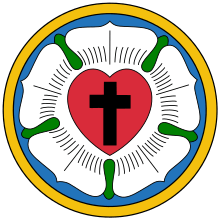Eric Norelius
Eric Norelius (26 October 1833 – 15 March 1916) was a Swedish-American Lutheran minister, church leader, and author.[3]
Eric Norelius, D.D., LL. D. | |
|---|---|
 Norelius with Polar Star Medal | |
| Born | Eric Norelius October 26, 1833[1] Hassela, Helsingland, Sweden |
| Died | March 15, 1916 (aged 82)[2] Vasa, Minnesota, U.S. |
| Occupation |
|
| Part of a series on |
| Lutheranism |
|---|
 |
|
|
Bible translators
|
|
Theologians |
|
|
Background
Eric Norelius was born on 26 October 1833 in Norrbäck, Hassela parish, in Nordanstig Municipality, Gävleborg County, Sweden. He received his early education at Hudiksvall's general school. In 1850, at the age of 17, Norelius emigrated to the United States. In May 1851, he accompanied Lars Paul Esbjörn on a visit to William Morton Reynolds, president of the newly renamed Capital University at Columbus, Ohio, and stayed on to become a student there,[4] with assistance from Esbjörn. After four years of studying, Norelius was ordained in 1855.
Career
Norelius moved to the newly formed congregations in Red Wing and Vasa, Minnesota in 1856. In 1858, he was called to serve the Swedish Lutheran congregation in Attica, Indiana. In 1863, he was called back to the Vasa and Red Wing congregations in Goodhue County.[5]
Lutheran Social Service of Minnesota traces its history to 1865 when Eric Norelius and his congregation took in four orphaned immigrant children and later opened Vasa Lutheran Home for Children. The Vasa Children’s Home was the first orphan home established by Swedish Lutherans in Minnesota.[6]
Norelius was one of the founders of the Augustana Synod, and he served as its president between 1870–1881 and 1901-1910. Norelius was also the founder and often president of the Lutheran Minnesota Conference of Augustana Synod, and he initiated Minnesota Elementar Skola, a predecessor of Gustavus Adolphus College.
Norelius was also active in the publishing field and began the publishing of Minnesota Posten, from 1857-58 which merged with Hemlandet. Norelius jointly published and edited Svensk Luthersk Tidskrift, which became Skaffaren after the first year of existence. He edited Missionären from 1870-71. Norelius was listed as editor-in-chief of Skaffaren until 1882. He was also the editor of Augustana for a brief period of time and the synod calendar Korsbaneret. From 1899 until 1909, he was editor or co-editor of Tidskrift för svensk evangelisk luthersk kyrkohistoria i Amerika, later called The Augustana Theological Quarterly.[7]
The last years of his life were spent researching and writing the history of the synod and the Swedish migration to and settlement in America. He published Vasa illustrata (1905) on the history of his congregation in Vasa, The history of the Swedish Lutheran congregations and the Swedish-Americans (1890) (Swedish: De svenska lutherska församlingarnas och svensk-amerikanernas historia). He also wrote a biography of Tuve Hasselquist (1900). Eric Norelius' papers are contained in the Swenson Swedish Immigration Research Center located on the campus of Augustana College in Rock Island, Illinois and in the College and Lutheran Church Archives at Gustavus Adolphus College in Saint Peter, Minnesota.[8]
Legacy
Gustavus Adolphus College honors the role of Eric Norelius in the foundation of the college. The four narthexes of Christ Chapel honor the first four college presidents, including Eric Norelius, founder of the College.[9] Norelius Hall is named for him. The Eric Norelius Award for the Outstanding Administrative Employee is awarded annually by Gustavus Adolphus College.[10] A commemorative bronze statue of Norelius was erected in 2015 in Lindström, Minnesota, alongside two additional statues of influential Swedish Immigrants Joris-Pelle Per Anderson and Daniel Lindström. All three Swedes immigrated between 1851 and 1853 and are honored for their significant contributions to the city of Lindström and the State of Minnesota.
References
- Gustavus Adolphus College. 1912 Annual. "Digital Collections from the College and Lutheran Church Archives" (PDF). Archived from the original (PDF) on March 26, 2014. Retrieved March 25, 2014.
- Augustana Evangelical Lutheran Church and Evangelical Lutheran Augustana Synod of North America. The Lutheran Companion. Rock Island, Illinois: Augustana Book Concern, 25 March 1916
- Eric Norelius papers, 1851-1916 (Swenson Swedish Immigration Research Center. Augustana College, Rock Island, Illinois)
- Richard W. Solberg, Lutheran Higher Education in North America (1885), p. 64
- Christian Cyclopedia (The Lutheran Church--Missouri Synod) Retrieved December 22, 2017.
- "LSS Vasa Children's Home". Lutheran Social Service of Minnesota. VCU Libraries. Retrieved December 22, 2017.
- Eric Norelius, Minnesota’s Church Father (by Bernhard Erling. Gustavus Adolphus College. 2006) "Archived copy" (PDF). Archived from the original (PDF) on August 28, 2008. Retrieved August 14, 2009.CS1 maint: archived copy as title (link)
- Eric Norelius, Minnesota’s Church Father (by Bernhard Erling Augustana Heritage > 2006) "Archived copy" (PDF). Archived from the original (PDF) on August 28, 2008. Retrieved August 14, 2009.CS1 maint: archived copy as title (link)
- "History of Christ Chapel". Gustavus Adolphus College. Retrieved December 22, 2017.
- "Quick Facts About the College". Gustavus Adolphus College Founding. Archived from the original on June 1, 2009. Retrieved June 11, 2009.
Further reading
- Johnson, Emeroy The Journals of Eric Norelius, a Swedish missionary on the American frontier (Augustana Book Concern. 1934)
- Ravenhill, Leonard Eric Norelius, Pioneer Midwest Pastor and Churchman (Augustana Book Concern. 1954)
- Peterson, Florence M. Turner Erik Norelius letters in the Gustavus Adolphus College Archives: Arranged chronologically (Gustavus Adolphus College. 1958)
![]()